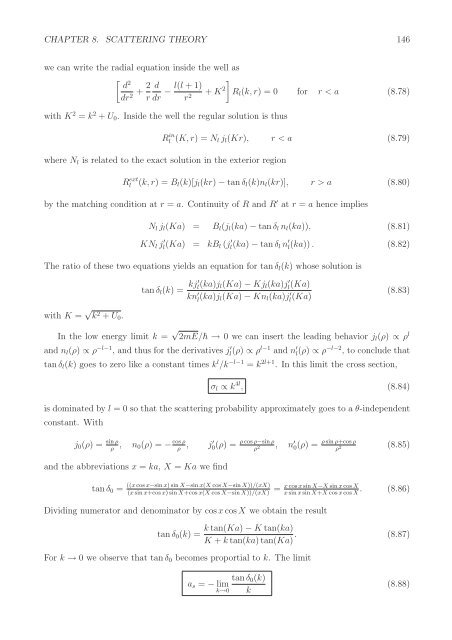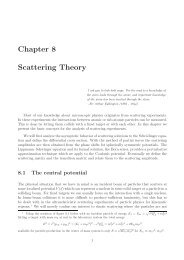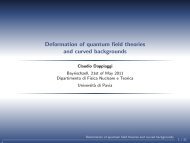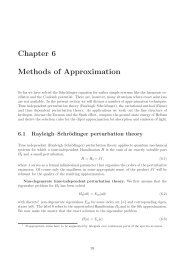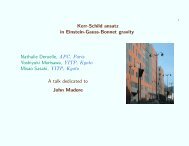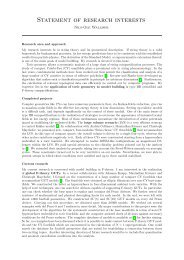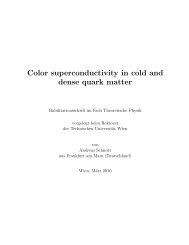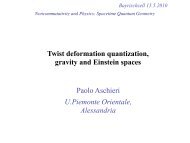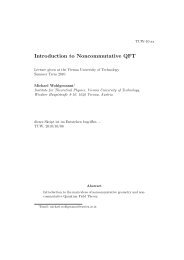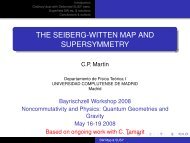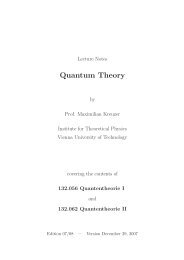Chapter 8 Scattering Theory - Particle Physics Group
Chapter 8 Scattering Theory - Particle Physics Group
Chapter 8 Scattering Theory - Particle Physics Group
Create successful ePaper yourself
Turn your PDF publications into a flip-book with our unique Google optimized e-Paper software.
CHAPTER 8. SCATTERING THEORY 146<br />
we can write the radial equation inside the well as<br />
[ d<br />
2<br />
dr + 2 ]<br />
d l(l + 1)<br />
− + K 2 R 2 r dr r 2 l (k,r) = 0 for r < a (8.78)<br />
with K 2 = k 2 + U 0 . Inside the well the regular solution is thus<br />
R in<br />
l (K,r) = N l j l (Kr), r < a (8.79)<br />
where N l is related to the exact solution in the exterior region<br />
R ext<br />
l (k,r) = B l (k)[j l (kr) − tanδ l (k)n l (kr)], r > a (8.80)<br />
by the matching condition at r = a. Continuity of R and R ′ at r = a hence implies<br />
N l j l (Ka) = B l (j l (ka) − tanδ l n l (ka)), (8.81)<br />
KN l j ′ l(Ka) = kB l (j ′ l(ka) − tanδ l n ′ l(ka)). (8.82)<br />
The ratio of these two equations yields an equation for tanδ l (k) whose solution is<br />
with K = √ k 2 + U 0 .<br />
tanδ l (k) = kj′ l (ka)j l(Ka) − Kj l (ka)j ′ l (Ka)<br />
kn ′ l (ka)j l(Ka) − Kn l (ka)j ′ l (Ka) (8.83)<br />
In the low energy limit k = √ 2mE/ → 0 we can insert the leading behavior j l (ρ) ∝ ρ l<br />
and n l (ρ) ∝ ρ −l−1 , and thus for the derivatives j ′ l (ρ) ∝ ρl−1 and n ′ l (ρ) ∝ ρ−l−2 , to conclude that<br />
tanδ l (k) goes to zero like a constant times k l /k −l−1 = k 2l+1 . In this limit the cross section,<br />
σ l ∝ k 4l , (8.84)<br />
is dominated by l = 0 so that the scattering probability approximately goes to a θ-independent<br />
constant. With<br />
j 0 (ρ) = sin ρ<br />
ρ ,<br />
n 0(ρ) = − cos ρ<br />
ρ ,<br />
j′ 0(ρ) =<br />
ρcos ρ−sin ρ<br />
ρ 2 , n ′ 0(ρ) =<br />
ρsin ρ+cos ρ<br />
ρ 2 (8.85)<br />
and the abbreviations x = ka, X = Ka we find<br />
tan δ 0 =<br />
((xcos x−sin x) sin X−sin x(X cos X−sin X))/(xX)<br />
(xsin x+cos x) sin X+cos x(X cos X−sin X))/(xX)<br />
Dividing numerator and denominator by cosxcos X we obtain the result<br />
tanδ 0 (k) =<br />
=<br />
xcos xsin X−X sin x cos X<br />
xsin x sin X+X cos x cos X . (8.86)<br />
k tan(Ka) − K tan(ka)<br />
K + k tan(ka) tan(Ka) . (8.87)<br />
For k → 0 we observe that tanδ 0 becomes proportial to k. The limit<br />
a s = − lim<br />
k→0<br />
tanδ 0 (k)<br />
k<br />
(8.88)


